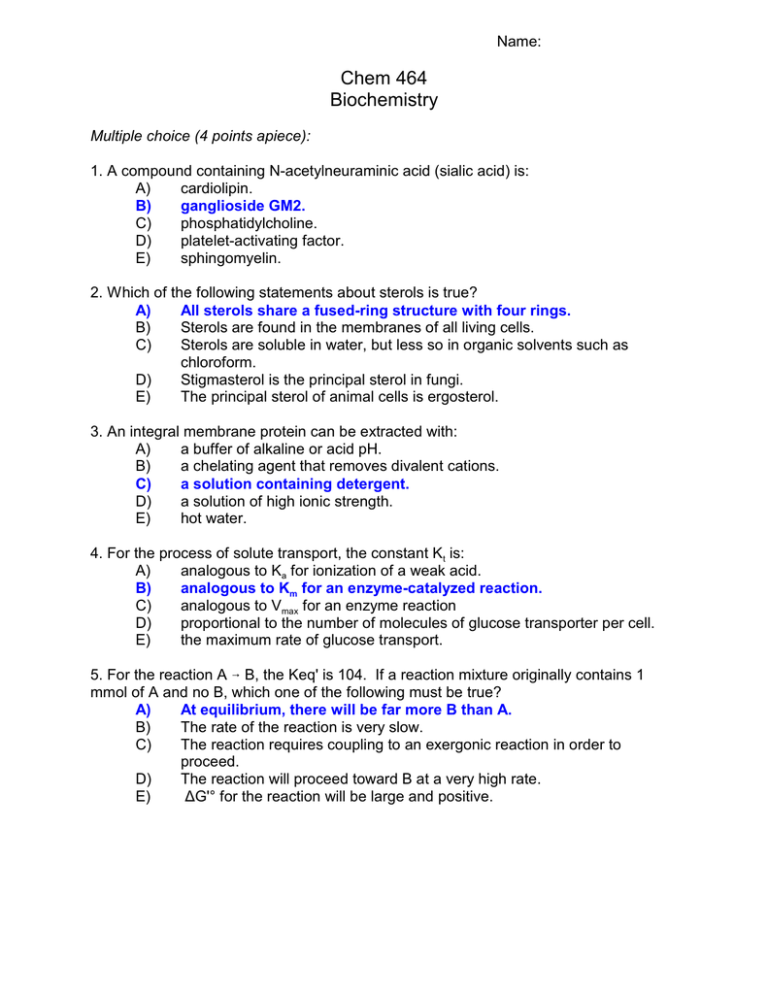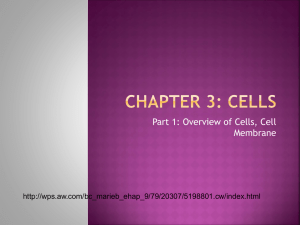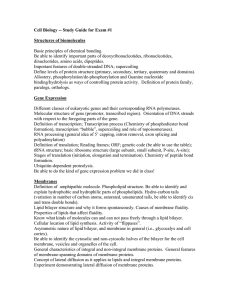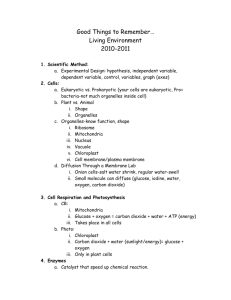Chem 464 Biochemistry
advertisement

Name: Chem 464 Biochemistry Multiple choice (4 points apiece): 1. A compound containing N-acetylneuraminic acid (sialic acid) is: A) cardiolipin. B) ganglioside GM2. C) phosphatidylcholine. D) platelet-activating factor. E) sphingomyelin. 2. Which of the following statements about sterols is true? A) All sterols share a fused-ring structure with four rings. B) Sterols are found in the membranes of all living cells. C) Sterols are soluble in water, but less so in organic solvents such as chloroform. D) Stigmasterol is the principal sterol in fungi. E) The principal sterol of animal cells is ergosterol. 3. An integral membrane protein can be extracted with: A) a buffer of alkaline or acid pH. B) a chelating agent that removes divalent cations. C) a solution containing detergent. D) a solution of high ionic strength. E) hot water. 4. For the process of solute transport, the constant Kt is: A) analogous to Ka for ionization of a weak acid. B) analogous to Km for an enzyme-catalyzed reaction. C) analogous to Vmax for an enzyme reaction D) proportional to the number of molecules of glucose transporter per cell. E) the maximum rate of glucose transport. 5. For the reaction A 6 B, the Keq' is 104. If a reaction mixture originally contains 1 mmol of A and no B, which one of the following must be true? A) At equilibrium, there will be far more B than A. B) The rate of the reaction is very slow. C) The reaction requires coupling to an exergonic reaction in order to proceed. D) The reaction will proceed toward B at a very high rate. E) ÄG'° for the reaction will be large and positive. 2 6. The standard reduction potentials (E'°) for the following half reactions are given. Fumarate + 2H+ + 2e- 6 succinate E'° = +0.031 V + FAD + 2H + 2e 6 FADH2 E'° = -0.219 V If you mixed succinate, fumarate, FAD, and FADH2 together, all at l M concentrations and in the presence of succinate dehydrogenase, which of the following would happen initially? A) Fumarate and succinate would become oxidized; FAD and FADH2 would become reduced. B) Fumarate would become reduced, FADH2 would become oxidized. C) No reaction would occur because all reactants and products are already at their standard concentrations. D) Succinate would become oxidized, FAD would become reduced. E) Succinate would become oxidized, FADH2 would be unchanged because it is a cofactor. 7. Restriction enzymes: A) act at the membrane to restrict the passage of certain molecules into the cell. B) are highly specialized ribonucleases that degrade mRNA soon after its synthesis. C) are sequence-specific DNA endonucleases. D) are very specific proteases that cleave peptides at only certain sequences. E) catalyze the addition of a certain amino acid to a specific tRNA. Longer Problems 12 points each YOU MAY SKIP TWO QUESTIONS 8. Compare and contrast the structure of a storage lipid to the structure of both glycerophospholipids and sphinolipids. Storage lipid - 3 fatty acid attached to a glycerol. Glycerophospholipid - 2 fatty acids attached to a glycerol, usually a C-16 or C-18 fatty acid in the 1 position, and a C-18 or C-20 unsaturated in the 2 position, and a phosphate in the 3 position. Several different compounds may be attached to the phosphate including ethnolamine, choline, serine, another glycerol or phosphitidy inostitol (a sugar). A sphingolipid has a sphingosine backbone that somewhat resembles a fatty acid attached to a glycerol. There is a fatty acid attached through a amide bond to the NH of sphinosine, and like glycerophospholipids there are a number of compounds that can be attached to the OH at the 1 position of the sphinosine 3 9. What are the four different fat-soluble vitamins and how are they used in your body. Vitamin A (retinol) - Can be derived from â-carotene or from fish oils, it is a visual pigment and a lack of vitamin A is associated with dry skin and night blindness. Vitamin D derived from sterols, it is converted to calcitriol in the liver and is necessary for Ca2+ uptake and proper bone formation Vitamin E a tocopherol an antioxidant associated with lipids and membranes Vitamin K the oxidation and reduction of this vitamin is essential in blood clotting. 10. We have seen examples of integral membrane proteins made with both á-helices and â-sheets. Describe the important structural features of these two kinds of proteins and give an example of a membrane transport protein that has that kind of structure. Both have an ‘inside-out’ structure in which the hydrophobic residues are on the outside of the protein interacting with the lipid bilayer and the hydrophilic residues (if any) and on the inside forming pores or interacting with the ions being transported. Helical integral membranes usually have 20-25 hydrophobic residues in a row, which is just enough to span the 30 Å of a lipid bilayer. There is also a preference for Tyr or Trp and the membrane surface, and for + charged residues to be located on the cytoplasmic side of a membrane spanning protein. Most of the transport proteins we studied were á-helical. The only â-sheets I remember were the porins. Un these proteins it only takes 7-9 residues to span the membrane, and typically every-other residue it polar so it is hard to pick up on a hydrophobicity plot. (but not aquaporin) 11. Tell me about the dynamics of the lipid membrane in the cell. Include such details as fluidity, how the composition changes with a changing temperature, movement of lipids along the surface of the lipid bilayer, movement of the lipid between leaflets of the membrane, movement of proteins along the surface of the lipid bilayer, and movement of proteins between leaflets of the membrane. Cell alters the composition of the membrane to keep in a ‘goldilocks’ state, not to solid, and not too fluid. There is much lateral diffusion of lipids within a leaflet, but no flipfloping of lipids between leaflets unless it is catalyzed by a series of enzymes like flippases (amino phospholipids from outside to inside) Floppases (phospholipids from inside to outside) Scrambleases (move in any direction, following concentration gradient). The lateral movement of lipids is not entirely free, they seem to be somewhat confined to lipid ‘corrals’ that seem to restrict the movement of lipids to areas defined by the structure of the proteins that lie just below the lipid bilayer. The integral membrane proteins that are in the membrane can also move laterally, but at a slow rate. There is no ‘flip-floping’ of the integral membrane proteins so they are always oriented in one way. The integral membrane proteins can be organized into membrane ‘rafts’ in which certain proteins and lipids associate together to form a ‘raft’ that is slightly thicker than the rest of the membrane, and can move along the surface of the membrane as a single unit. 4 12. Explain how an epithelial cell in your intestine transports glucose into the cell and then transports it out into the blood. What ions or other transport proteins are involved in this process. Here a diagram like figure 11-43 really helps. The lumen of the intestine has a high concentration of Na+ when compared to the inside of the epithelial cell. Thus one needs and Na+/glucose symporter located on the lumen side of the epithelial cell to bring glucose into the cell (2Na+/glucose). The cell has a higher concentration of glucose than the blood, so the cell uses the GLUT2 uniporter to let the glucose slide down its concentration gradient and out into the blood. Finally, so the Na+ does not build up in the cell, the Na+ /K+ ATPase pumps Na+ out of the cell and into the blood and bring K+ back into the cell. 13. In Chapter 12 you were asked to study any one of the six general types signal transduction systems on your own. Tell me about what you learned. There is no ‘one’ answer for this question. I will check each individual answer against the text for completeness and correctness. 13. The reaction Glucose + Pi 6Glucose -6- phosphate + H2O has a ÄGo’ of 13.8 kJ/mol The reaction ATP + H2O 6 ADP + Pi has a ÄGo’ of -39.5 kJ/mol What is the ÄGo’ for the reaction Glucose + ATP 6 Glucose-6-P + ADP Since the two equations add together to make the final equation, the two ÄG’s can simply be added together. 13.8 kJ -39.5 kJ = -25.7 kJ What is the K for this reaction? ÄG=-RTlnK, Since R is in J/K mol ÄG must be in J I will assume T = 298K -25700=-8.314(298)lnK -25700/(-8.314*298) = 10.37=lnK e10.37 = K = 32,000 Since I did not give you a T and I did not hand out a sheet with R I will have to be flexible in grading this answer Given the cellular concentrations of reactants and products given below, calculate the actual ÄG for this reaction in a cell [ATP]=3.38 mM, [ADP]=1.32 mM, [Glucose]= 4.5 mM [Glucose-6-P]=0.5 mM ÄG rxn = ÄG o’ +RTlnQ =-25,700+8.314(298)ln[.0005×.00132]/[.00338×.0045] =-25700 + 2480 ln(.043) =-25700+-7790 = -33480 J or -33.48 kJ 5 14. Define the following terms: (1.5 points / term) Ligase - We will get a better definition in later chapters, but for now it is an enzyme that joins pieces of DNA together. plasmid - a small circular piece of DNA that replicates independently in a bacterial cell. transformation - When a bacterial cell takes in a foreign piece of DNA and then starts expressing the genes on that piece of DNA. sticky end - When the 3' and 5' strands on the end of a piece of DNA do not overlap so a few bases are exposed so they can bind to a second piece of DNA. ori - Origin of replication - the place on a bacterial chromosome where replication starts. electroporation - Subjecting cells to a voltage pulse that disrupts the cell membrane enough to allow the cell to take in exogenous DNA. a competent cell - a cell that can take in exogenous DNA YAC - Yeast Artificial Chromosome - A large piece of DNA incororated into a yeast cell that includes all the sequences necessary to replicate in that yeast like a separatr chromosome. 6 1 -B, 2-A, 3-C, 4-B, 5-A, 6-B, 7-C





